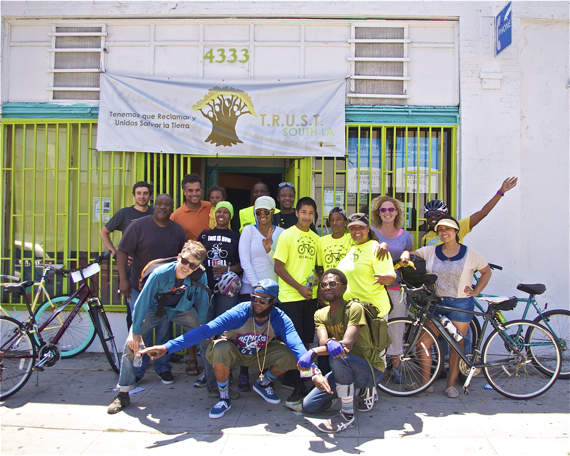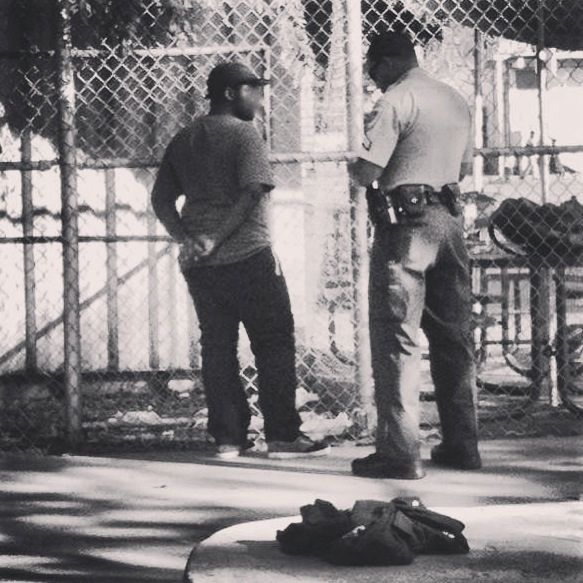A Case for the Incorporation of Questions of Access Into Planning for Complete Streets
1:01 PM PDT on June 19, 2013

"David!" I yelled, gesturing at City Planning's David Somers to come over and listen to what the residents playing cards in their yard were saying about the need for a stoplight at the intersection outside their front gate.
Too many people had come crashing through it, they told me.
And if it wasn't their gate, they pointed across the street, it was the damaged stone wall kitty-corner from their yard.
Just so I could fully grasp how bad the intersection at 82nd and Hooper was, the woman pulled out her camera and showed me a photo of a large red SUV parked practically on top of the hot water heater outside her bedroom window.
She had been sleeping on the other side of that wall, she said.
"They didn't even give him a breathalyzer!" another resident shook his head. "Even though there were beer bottles fallin' out of the car!"
The driver had apparently tried to run away and hide, at first. Then, he came back and tried to drive the truck off (or something of that nature) before the Sheriffs finally stepped up and told him that wasn't how things worked when you crashed into a house.
Hooper's just too fast of a street, they all reiterated. Wide open and curvy, people apparently feel like they can slalom along it, especially after they've had a few drinks. Which never ends well for anybody. And by "anybody," I mean the residents in the area.
David listened, expressed dismay, and finally moved off to join the rest of the group participating in the Complete Streets Ride as they rolled out. He was interested in their concerns, but there wasn't much he could do. Florence-Firestone is unincorporated, so it's not within the city's jurisdiction.
I stayed behind to chat for a few more minutes.
The great benefit of participating in slow-moving community group rides, I find, is that we attract a lot of attention from curious residents. Both the rides and the door-knocking outreach I sometimes try to do beforehand allow me to engage a wide cross-section of people on how they feel about their neighborhoods, including any major concerns they may have and ideas for how they could be rectified.
The residents at this location really only had two major complaints, one man said: the need for a stoplight at the intersection and the need to be protected from those that are supposed to protect and serve.
He was tired of being followed by the cops for several blocks around the neighborhood where he had lived for years. Or being stopped and questioned for no reason.
He was active in his community, he said. He worked with a foundation to distribute food and support activities for youth. Everyone called him "Coach." And yet, even a well-respected, middle-aged community advocate like himself was regularly treated like a common criminal just because he was black.
Enough was enough.
The others nodded.
I nodded, too.
He wasn't the first man to say this to me.
In fact, I can think of few conversations I have had with men in the street about improving neighborhoods in South L.A. where the question of harassment by law enforcement has not come up.

Access to the streets, for many of them, comes at the cost of regularly being followed, stopped, and questioned about who they are, where they are going, what their business is, and whether they have stolen property, weapons, or illegal substances on their person.
It's frustrating and humiliating, they say.
That doesn't mean that these men don't care about other things.
A young gang-banger who lived along Compton Ave., for example, pointed to the heavily cracked asphalt and potholes just outside his front gate and the poor condition of the garbage-strewn strips of dead and treeless grass alongside the curb as places the powers-that-be could start to make his neighborhood feel better about itself.
But equal access to streets so that youth like him can engage in positive activities, like riding to Critical Mass (as he said he sometimes enjoyed doing), or so others will not have to suffer being regularly humiliated in front of their children, neighbors, or the local businesses they patronize is always near the top of the list with many men of color that I speak with.
It comes up so often, in fact, that I can't help but think that some of the readers of our South L.A. articles must feel I'm a bit of a broken record and not focused enough on more concrete planning issues.
To me, however, the prevalence of the concern is a signal that the neither the city nor law enforcement has made a genuine commitment to dealing with biased policing among the rank-and-file, despite all lip-service to the contrary. This matters because, until these residents are treated with equal respect and dignity in the streets, the city will always struggle to engage them on most other issues that would benefit from community input.
Think about it this way: How willing would you be to dedicate your time to investing in your community if you were treated as the human incarnation of neighborhood blight every time you stepped outside your door? How often would you participate in beautification projects, attend community events, lend your voice to community meetings, or involve your child in recreational programs if you knew that, every time you biked or walked back and forth to an event with your young daughter, you were likely to get stopped and questioned by police in front of her?
Despite these obstacles, I know many men that continue to work towards making their neighborhoods better places.
For many others, however, it can be discouraging and contribute to their disenfranchisement.
Which means that, when I and others come through doing outreach for this or that community meeting to talk about community plans, mobility, or street-scaping, people sometimes have a hard time connecting to what we are talking about.
Few things, I find, shut a conversation down faster and more effectively than launching into a spiel about bike lanes. Leading with infrastructure makes some assume that I am going to tell them what is good for them and that I will not be open to hearing about their own perceptions of their needs. Even when those needs are linked to cleaner and safer streets.
But, for all the listening I and some of the great folks involved with the South L.A. Mobility Advisory Committee* are prepared to do to engage folks on planning issues, until the city commits to dealing with the issue of equal access, it will likely continue to be a challenge to get people fully on board with improving streets they do not have the privilege of enjoying peacefully.
Anything city planning and LADOT can do to collaborate with law enforcement to encourage better community-based policing strategies, foot and biking patrols, and making neighborhoods feel like communities as part of their outreach process and implementation efforts can only benefit the area. Young men could finally feel better about themselves and their potential to make positive contributions to their neighborhoods. And our readers would finally get a break from seeing this issue pop up in every third article I write. Everybody wins!
++++
*The Mobility Advisory Committee is organized by representatives of TRUST South L.A. and Community Health Councils (CHC), in collaboration with the LACBC and the LADOT's Bike Program. They work on creating visions for and advocating on behalf of friendlier streets for cyclists and pedestrians via community outreach, collaboration with other advocacy organizations, events sited in communities, and engagement of city planning. They meet monthly (next mtg.: June 29th, 10:30 - noon, at CHC) and are holding a Complete Streets Forum this Thursday evening. Click here for more details.
Sahra is Communities Editor for Streetsblog L.A., covering the intersection of mobility with race, class, history, representation, policing, housing, health, culture, community, and access to the public space in Boyle Heights and South Central Los Angeles.
Stay in touch
Sign up for our free newsletter
More from Streetsblog Los Angeles
Eyes on the Street: New Lincoln Park Avenue Bike Lanes
The recently installed 1.25-mile long bikeway spans Lincoln Park Avenue, Flora Avenue, and Sierra Street - it's arguably the first new bike facility of the Measure HLA era
Brightline West Breaks Ground on Vegas to SoCal High-Speed Rail
Brightline West will be a 218-mile 186-mile-per-hour rail line from Vegas to Rancho Cucamonga - about 40 miles east of downtown L.A. - expected to open in 2028
This Week In Livable Streets
Active Streets Mission-to-Mission, LAPD reports on its use of force in 2023, Pasadena Transit plans, Metro subway construction, and more




